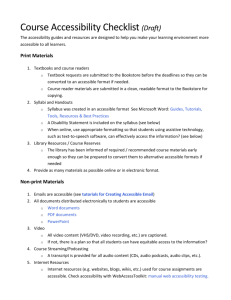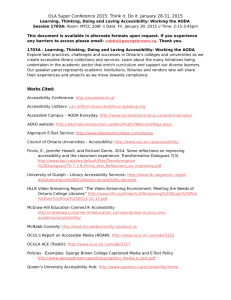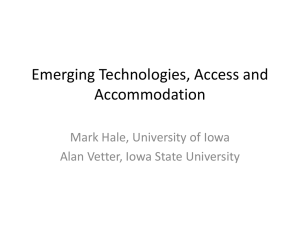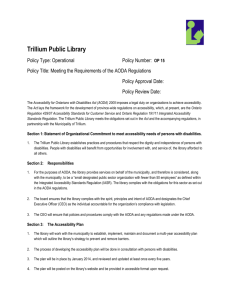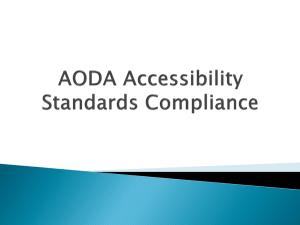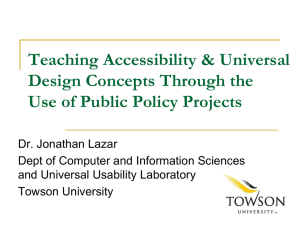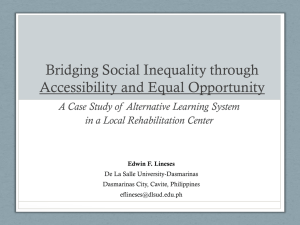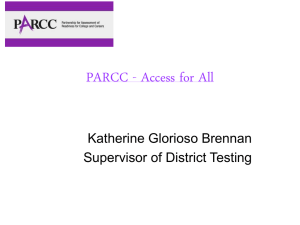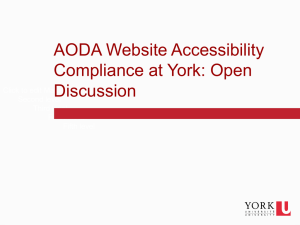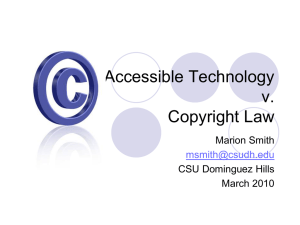View the Powerpoint Presentation
advertisement
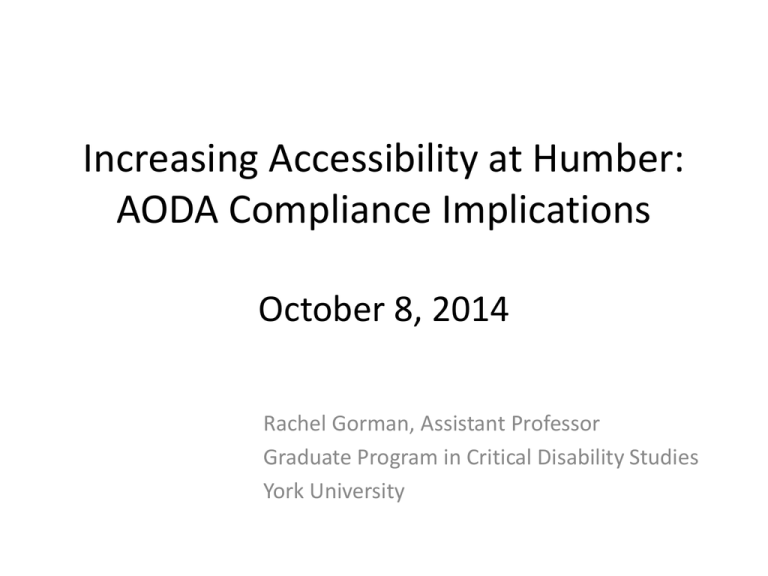
Increasing Accessibility at Humber: AODA Compliance Implications October 8, 2014 Rachel Gorman, Assistant Professor Graduate Program in Critical Disability Studies York University What is access? How will we know when we have it? • • • • For staff? For students? For faculty? For the public? Understanding Access in a Rights Framework • • • • • Ontario Human Rights Code (1962) Canadian Human Rights Act (1977) Canadian Charter of Rights and Freedoms (1982) Accessibility for Ontarians with Disabilities Act (2005) UN Convention on the Rights of Persons with Disabilities (2006) Human Rights Principles and the UNCRPD • • • • • Dignity Autonomy Participation, Inclusion, and Accessibility Non-discrimination and Equality Respect for Difference Accessibility Standards in the Context of Rights • In the long struggle to adopt the AODA and to develop its standards, disability rights activists and allies have consistently raised concerns about the need for compliance mechanisms • However, the Act provides guidelines in the context of international, national, and provincial rights; the standards on their own may not be adequate to ensuring that human rights standards are met Small Group Discussion—UNCRPD • With your group, discuss this narrative in relation to the five UNCRPD principles. What are some examples of violations of these principles? – Dignity – Autonomy – Participation, Inclusion, and Accessibility – Non-discrimination and Equality – Respect for Difference Small Group Discussion—OHRC • The OHRC focuses on “effect not intent.” • Using your experience as post-secondary administrators and teachers, look for examples in this narrative where institutional legal and/or policy barriers created the effect of a violation, regardless of intent AODA and the Integrated Access Standards (2011) • The AODA outlines five specific policy domains – Customer service – Employment – Information & Communication – Transportation – Built environment Brainstorm • Recall or imagine a situation in which existing institutional and social barriers limit your ability to create a more accessible environment • What were the external barriers? • What are some contradictions within institutional compliance that limit your ability to increase accessibility? The work of access • Inaccessibility can be mitigated or exacerbated by other aspects of social privilege or oppression • Ideas of what is accessible are organized through dominant ideologies of class, gender, race, culture, and sexual identity/orientation • The post-secondary environment often creates barriers that students were not aware of before attending, and could not have anticipated • Post-secondary environments and the “climate of distress” Small Group Exercise—The work of accommodation • In your group, map out a student’s process of seeking accommodation—what are the steps? Estimate the number of hours it takes for a student to complete the accommodations process. Factor in time for other accessibility issues the student may face, e.g. transportation, cost • Bonus: map out an employee’s process of seeking accommodation Small Group Discussion—The work of accommodation • Looking at the map of the accommodations process, indicate points which raise a flag for you regarding one or more of the five human rights principles of the UNCRPD, which are: – Dignity – Autonomy – Participation, Inclusion, and Accessibility – Non-discrimination and Equality – Respect for Difference AODA and the Integrated Access Standards (2011) • The Integrated Access Standards include the first four: customer service, employment, Information & Communication and Transportation • Section 16 outlines Training for Educators • Humber’s Centre for Human Rights, Equity & Diversity has created an excellent Accessibility Awareness Training for Educators power point tool AODA Training for Educators • Shifts the focus from understanding disability as an individual issue (accommodations) to understanding accessibility in the context of the social model of disability (universal design). • Brainstorm: what are some concrete examples of universal design you have heard about or used? Emerging Recommendations • What are some key institutional barriers you have identified in your group discussions? • What are some policy recommendations you would suggest pursuing? • What institutional pathways are available for developing these recommendations?
